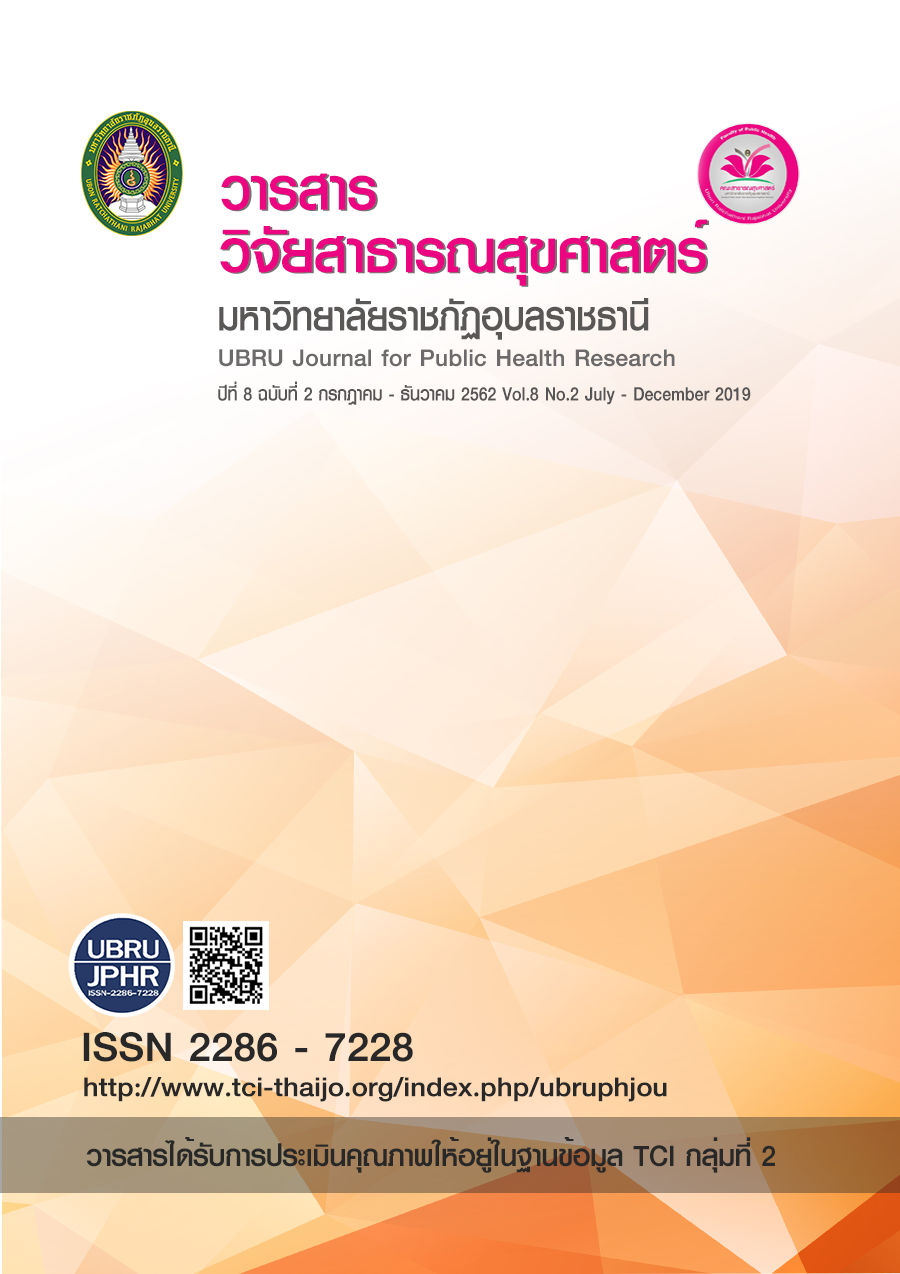Effect of life-skills development program on the prevention of sexual-risk behaviors in early adolescents
Keywords:
Life skills development program, sexual risk behaviors, early adolescentsAbstract
This study is a quasi-experimental study pretest and posttest design. The purpose of this study was to investigate the effects of a life skills development program on the prevention of sexual risk behaviors which applied the life skills concept to the participatory learning process. The samples were students in Prathomsuksa 5 and 6. The experimental group of 35 students received a life skills development program to prevent sexual risk behaviors at Wat Bang Sai Nork Community School. And the comparison group was made of 35 students of Wat Khlong Tan School where they received a normal teaching method. The samples were randomly selected from the participating schools. The instruments used in the study were divided into 2 sets. Set 1 was a life skills development program to prevent sexual risk behaviors, and Set 2 was a self-administered questionnaire divided into 4 parts as follows: Part 1 is the sex education measure which has the validity at 0.75, Part 2 is the analytical thinking skills for risky behaviors that lead to sexual assault with a validity at 0.72, Part 3 is decision-making and problem-solving skills with a validity tested at 0.81, and Part 4 is measurement of communication skills and confidence with a validity at 0.79. The data were analyzed by percentage, mean, standard deviation Chi – square test, Independent t-test and Paired t-test. The result was found that after the experiment, analytical thinking about risky behaviors, part 2, that leads to sex, decision making and problem solving (part 3), and communication and interpersonal skills (part 4) are higher than the comparison group and higher than before pre-test significantly (p<0.001). This study can conclude that a life skills development program to prevent sexual risk behaviors is better than normal teaching. The program can be applied in conjunction with regular instruction to improve the skills of early adolescenceReferences
กนิษฐา จำรูญสวัสดิ์, จรวยพร สุภาพ และวิริณธิ์ กิตติพิชัย. (2553). การพัฒนาทักษะการสื่อสารเพื่อป้องกันความรุนแรงทางร่างกายและทางเพศใน โรงเรียนขยายโอกาสทางการศึกษา จังหวัดสมุทรสาคร. วารสารสาธารณสุขและการพัฒนา. 8(1), 70-83.
กรมสุขภาพจิต กระทรวงสาธารณสุข. (2543). คู่มือการฝึกอบรมแบบมีส่วนร่วม. นนทบุรี: โรงพิมพ์วงศ์กมลโปรดักชั่น.
กลุ่มงานส่งเสริมสุขภาพ. (2561). รายงานการดำเนินงานคลินิกวัยรุ่นในจังหวัดพระนครศรีอยุธยา. พระนครศรีอยุธยา: สำนักงานสาธารณสุข จังหวัดพระนครศรีอยุธยา.
ณัฐกฤตา ศิริโสภณ, ฐิตารีย์ เธียรสุทัศน์ และสมคิด ปราบภัย. ประสิทธิผลของโปรแกรมการสร้างเสริมทักษะชีวิตทางเพศศึกษาต่อการเปลี่ยนแปลงพฤติกรรมการป้องกันความเสี่ยงทางเพศของนักเรียนหญิงชั้นมัธยมศึกษาตอนต้นโรงเรียนบางหลวงวิทยา จังหวัดนครปฐม. วารสารวิชาการ สถาบันการพลศึกษา. 7(3), 89-103.
เนตรทราย ปัญญชุณห์, ธราดล เก่งการพาณิช, สุปรียา ตันสกุล และสุพร อภินันทเวช. (2552). การเสริมสร้างทักษะชีวิตเพื่อป้องกันการมี เพศสัมพันธ์ของนักเรียนหญิงชั้นมัธยมศึกษาตอนต้น. วารสารสุขศึกษา. 32(11), 32-41.
ริษา บุนนาค, ลักขณา เติมศิริกุลชัย, ภรณี วัฒนสมบูรณ์ และอาภาพร เผ่าวัฒนา. (2556). ประสิทธิผลของโปรแกรมทักษะชีวิตในการป้องกันพฤติกรรมเสี่ยงที่นำไปสู่การมีเพศสัมพันธ์ของนักเรียนชั้นมัธยมศึกษาตอนต้น จังหวัดนครปฐม. วารสารสาธารณสุขศาสตร์. 43(1), 80-93.
วันวิสาข์ บัวลอย, มณีรัตน์ ธีระวิวัฒน์, ภรณี วัฒนสมบูรณ์ และนิรัตน์ อิมามี. (2557). ประสิทธิผลของโปรแกรมการเรียนรู้เรื่องเพศศึกษาเพื่อป้องกันพฤติกรรมเสี่ยงต่อการมีเพศสัมพันธ์ของนักเรียนชั้นมัธยมศึกษาปีที่ 2 อำเภอสามพรานจังหวัดนครปฐม. รามาธิบดีพยาบาลสาร. 20(1), 127-142.
วิโรจน์ อารีย์กุล. (2553). การดูแลสุขภาพและการให้คำแนะนำวัยรุ่น (Adolescent Health Care and Supervision). กรุงเทพฯ: รุ่งศิลป์การพิมพ์.
สายฝน เอกวรางกูร. (2556). พฤติกรรมเสี่ยงทางเพศของเยาวชน. วารสารเกื้อการุณย์. 20(2), 16-26.
สุภาวดี วรมาลี, กนิษฐาจำรูญสวัสดิ์, วิริณธิ์ กิตติพิชัย และนฤมล เอื้อมณีกุล. (2559). โปรแกรมพัฒนาเจตคติต่อบทบาททางเพศ และทักษะชีวิตต่อการป้องกันพฤติกรรมเสี่ยงทางเพศของนักเรียนชายระดับชั้นประถมศึกษาปีที่ 5 จังหวัดลพบุรี. ธรรมศาสตร์เวชสาร. 16(3), 456-466.
สำนักอนามัยการเจริญพันธุ์ กรมอนามัย กระทรวงสาธารณสุข. (2560). คู่มือพัฒนาศักยภาพแกนนำวัยรุ่น. นนทบุรี: โรงพิมพ์ชุมนุมสหกรณ์การเกษตร แห่งประเทศไทย จำกัด.
สำนักอนามัยการเจริญพันธุ์ กรมอนามัย กระทรวงสาธารณสุข. (2561). สถานการณ์อนามัยการเจริญพันธุ์ ในวัยรุ่นและเยาวชน ปี 2560. นนทบุรี: กรมอนามัย กระทรวงสาธารณสุข.
อนุชิต วรกา. (2558). ทักษะชีวิตกับพฤติกรรมเสี่ยงทางเพศของนักเรียนชั้นมัธยมศึกษาตอนต้น จังหวัดกาญจนบุรี. วิทยานิพนธ์วิทยาศาสตรมหาบัณฑิต สาขาวิชาสุขศึกษาและพฤติกรรมศาสตร์ มหาวิทยาลัยมหิดล.
อภินันท์ วัชเรนทร์วงศ์. (2553). ปัจจัยด้านสังคมกับพฤติกรรมเสี่ยงต่อการมีเพศสัมพันธ์ของนักเรียนมัธยมศึกษา จังหวัดสมุทรสาคร. วิทยานิพนธ์วิทยาศาสตรมหาบัณฑิต สาขาวิชาสุขศึกษาและพฤติกรรมศาสตร์ มหาวิทยาลัยมหิดล.
WHO. (1994). Life skills education for children and adolescence in school. Geneva: WHO.
Downloads
Published
How to Cite
Issue
Section
License
เนื้อหาและข้อมูลในบทความที่ลงตีพิมพ์ในวารสารวารสารวิจัยสาธารณสุขศาสตร์ มหาวิทยาลัยราชภัฏอุบลราชธานี ถือเป็นข้อคิดเห็นและความรับผิดชอบของผู้เขียนบทความโดยตรงซึ่งกองบรรณาธิการวารสาร ไม่จำเป็นต้องเห็นด้วย หรือร่วมรับผิดชอบใดๆ
บทความ ข้อมูล เนื้อหา รูปภาพ ฯลฯ ที่ได้รับการตีพิมพ์ในวารสารนี้ ถือเป็นลิขสิทธิ์ของวารสารฯ หากบุคคลหรือหน่วยงานใดต้องการนำทั้งหมดหรือส่วนหนึ่งส่วนใดไปเผยแพร่ต่อหรือเพื่อกระทำการใดๆ จะต้องได้รับอนุญาตเป็นลายลักอักษรณ์จากบรรณาธิการวารสารนี้ก่อนเท่านั้น


